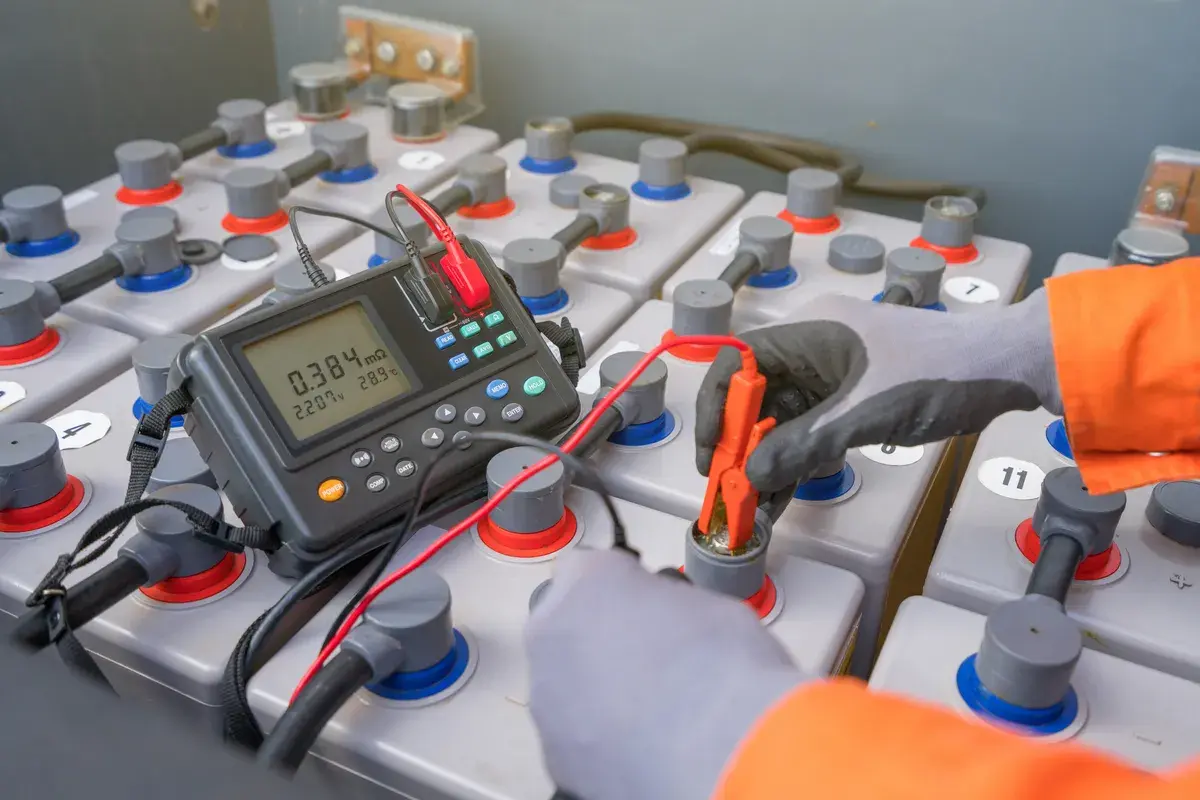What is the Internal Resistance of a Battery?
Internal resistance is sometimes known as the “gatekeeper” of a battery. Batteries are a source of voltage, but they all have a certain amount of internal resistance that restricts the voltage delivery and determines the battery’s runtime.
Internal resistance is measured in milliohms, and there are a variety of different factors that contribute to the level of internal resistance, including:
- Size
- State of charge
- Internal chemistry
- Age
- Temperature
- Discharge current
Tracking a battery’s internal resistance assists in defining its capabilities, estimating its performance, and understanding its state of health.
In this blog, we’ll go over why internal resistance has an effect on a lift truck battery’s performance and discuss ways to check the internal resistance and mitigate some of that effect.
How to Find Voltage Drop in a Battery
When electrical current is flowing through a circuit, the voltage output is always lower than the input - that difference is known as the voltage drop.
Voltage drop is the product of current and resistance - so by understanding the amount of voltage drop, you can determine how energy efficient your battery.
The lower the internal resistance, the better the battery performance is. The higher internal resistance in a battery, the more the battery will heat up creating a voltage drop.
Battery Electrolyte and Internal Resistance
What causes higher internal resistance in a battery? It varies depending on of the battery’s composition.
Nickel-based batteries:
For nickel-based batteries, crystalline formation contributes to a higher level of internal resistance and can be reversed with deep cycling.
Crystalline formation, sometimes known as the “Memory effect”, occurs when a nickel-based battery is not charged properly.
If they are repeatedly recharged after being only partially discharged, the battery appears to “remember” the lower level of capacity and its overall capacity is reduced.
To prevent this effect, users should periodically discharge the battery down to one volt per cell, about every few months or so.
Lead Acid batteries:
For lead acid batteries, sulfation and grid battery corrosion can cause an increase in internal resistance, as well as a lower temperature.
Grid corrosion happens when the lead of the positive grid converts into lead dioxide and collapses the lead plates as a result.
Grid corrosion is one of the most common failures in a lead acid battery’s service life and can be reduced but can’t be avoided altogether.
Sulfation can be avoided with proper charging practices, which means avoiding partial charges and always allowing it to fully discharge, fully recharge and go through its required cool down period after charging.
Lithium-ion batteries:
For lithium-ion batteries, aging and continued use will lead to a build-up of solid electrolyte interphase, or SEI, on the anode. This build-up grows thicker over time and obstructs interaction with the graphite, which increases its internal resistance.
Many lithium-ion manufacturers have developed their own way to offset this effect using special additives to the electrolyte. As lithium-ion battery technology has evolved, their efficiency has greatly improved.
How to Check Internal Resistance
One of the main reasons you might want to test for a battery’s level of internal resistance is to understand its condition, as a higher-than-normal reading will indicate that the battery is near the end of its working life.
This reading is most useful when compared to a reading taken from the battery when first put into service.
There are different ways to check the internal resistance of a battery, and it is by looking at the Direct Current (DC) and Alternating Current (AC):
- Direct Current - measures the voltage drop at a given current, looks only at pure resistance
- Alternating Current - takes reactance into account and provides the impedance, which may be different from the DC reading but both are correct
Battery Internal Resistance Comparison
A battery’s internal resistance level varies depending on all the factors listed above but also on its state of charge.
Nickel-based batteries:
- The internal resistance in these types of batteries decreases throughout discharge until about halfway through the discharge cycle, then it steadily rises up again.
Lead Acid batteries:
- The internal resistance rises throughout the discharge, which is caused by a depletion of the electrolyte as it becomes more watery, which decreases its specific gravity.
- Lead acid batteries have a voltage drop from internal resistance from continuous high current discharge.
Lithium-ion batteries:
- The resistance of lithium-ion is fairly flat from empty to full charge, allowing for its performance to remain stable.
- Lithium-ion batteries have one of the lowest internal resistances available, and their high level of Coulombic Efficiency, or CE rating, is a testament to this.
Internal Resistance and Lift Truck Battery Performance
Understanding the concept of internal resistance is useful for anyone working with and making decisions about forklift batteries on a regular basis.
Batteries are becoming more than just an after thought power source; they are a technology investment that can help increase productivity, output, and overall organizational efficiency.
Lithium-ion batteries have low internal resistance which is why they outperform other types. Understanding the role that internal resistance plays will put you in a better position to make informed decision about your forklift battery.












